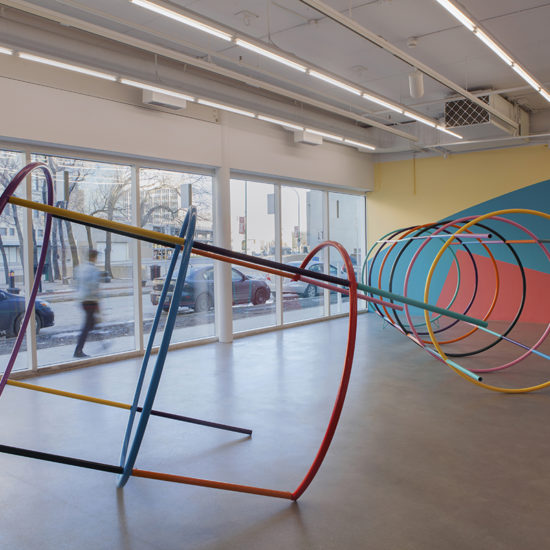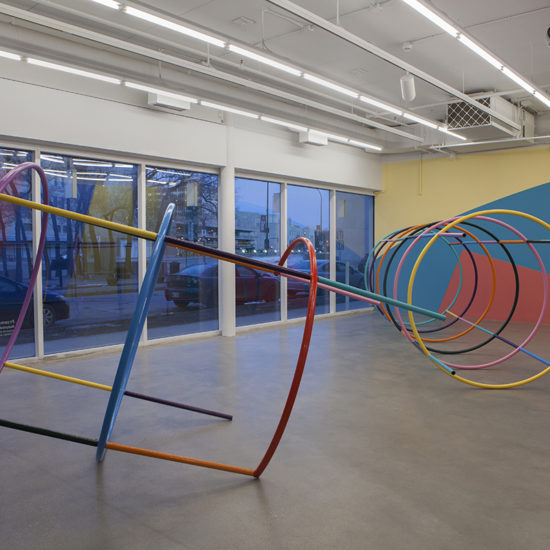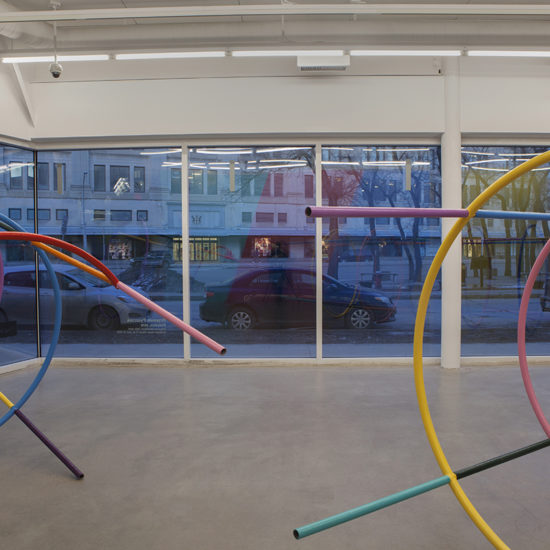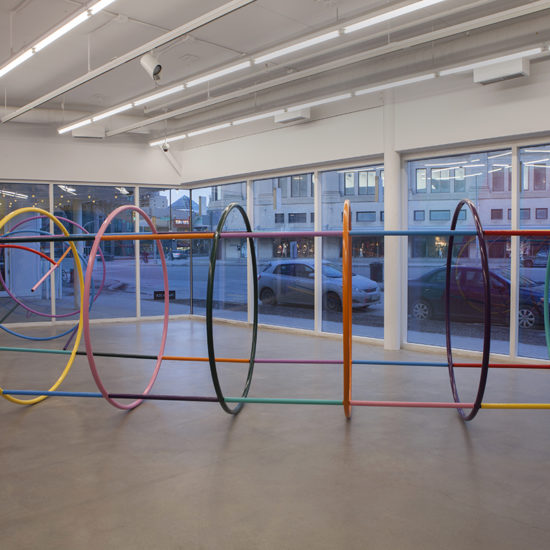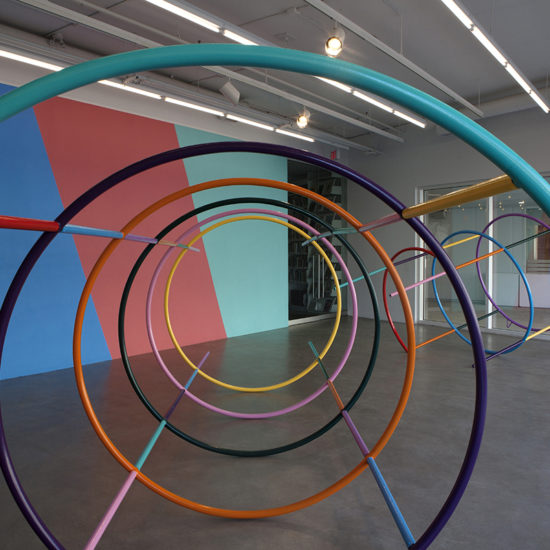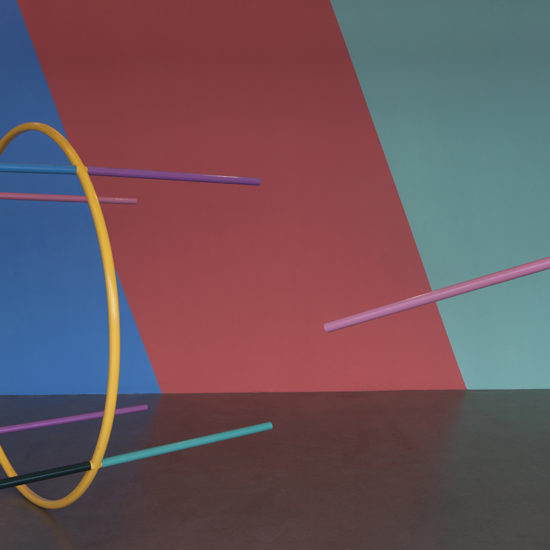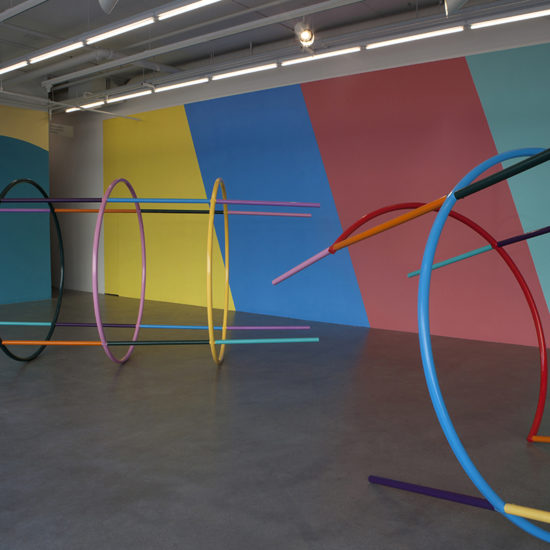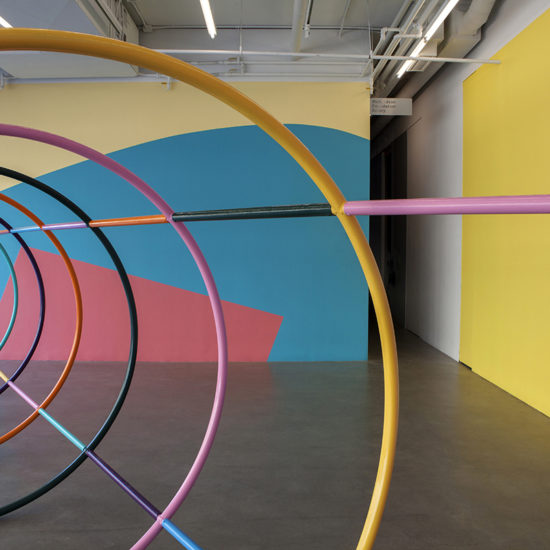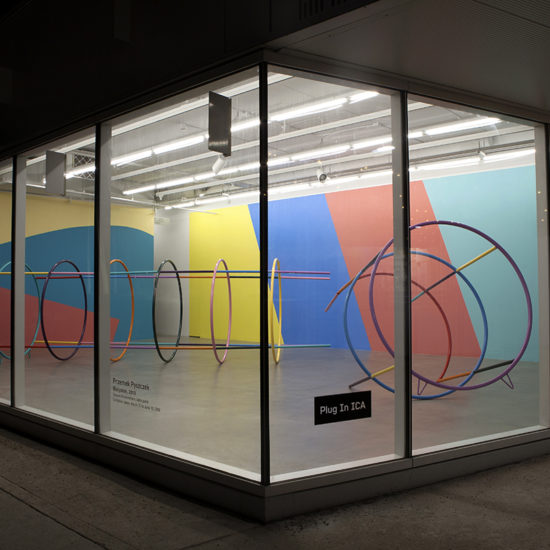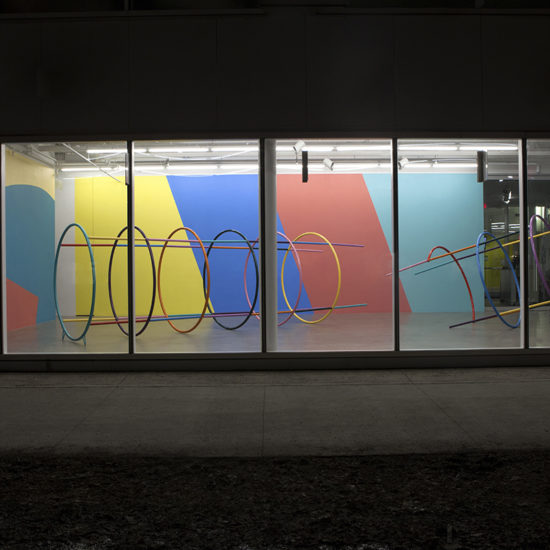Przemek Pyszczek: Białystok
March 31, 2018 to June 10, 2018
Opening Reception:
March 29, 2018 | 7pm
Polish Guided Tour with Przemek Pyszczek:
April 3, 2018 – 6:00pm
Artist Talk and Polish Tour with Przemek Pyszczek
April 3, 2018 | 7pm
Talk: https://plugin.org/video-artist-talk-with-przemek-pyszczek/
Curatorial tour with Jenifer Papararo
Saturday, April 21 | 3pm
Visite guidée en français par Janelle Tougas
Samedi, 5 mai | 15h
Visita guiada en español con Francesca Carella Arfinengo
Sábado, 19 de Mayo | 15h
Respondent Series Talk with Art City Directors
Wednesday, May 23 | 7pm
Interpreting [Interrupting] Youth Screening & Panel
Sunday, June 10 | 3pm
Colourful hues of hand brushed steel-poles create two centralized geometric forms in Białystok – Przemek Pyszczek’s first solo exhibition in Canada and in his home town of Winnipeg. Heavily influenced by the architectural and civic structures from his birth place Białystok in Poland, Pyszczek builds a colourful, expansive and fractured sculpture that simultaneously captures a conformity and resistance to public housing infra-structures in Communist Poland, which turned from grey to an explosion of colour with the fall of the Iron Curtain.
As a form of claiming public space after the communist state collapsed, colour marked a transition from a monochromatic social state to an individualist multi-colored sprawl. The well-known polish literary writer Andrzej Stasiuk wrote in the cultural journal Tygodnik Powszechny that: “Under communism the basic building material was greyness. That’s what we all remember. Even those of us who have forgotten everything else. Communism was grey – this truism has poisoned our minds. And so, after our heroic liberation, our first reaction was to rush to a paint shop. And that’s what my country looks like now: as if a monkey had played around with a paintbrush.”i Pyszczek’s palette is compiled from these colourful reprisals of civic space in reference to the residential concrete blocks that were and still are painted in an array of pastel hues, which the writer Martha Kirszenbaum, when discussing Pyszczek’s work, refers to as ‘koloroblok’ and situates within the working class.ii
The city’s colour palette works as a cue for Pyszczek, and an accent that draws the artist’s attention to the architectural details of these working class neighbourhoods. The defining elements and structure of his sculptures draws from the architectural details of these colour blocks. The latticework that forms hand railings, the flourishes of pattern in balcony balustrades, the graphic patterning of fencing, the decorative embellishments of rod iron window and door security. These functionally ornamental frames are dividers often delineating the space between public and private. Pyszczek uses these barriers as references in his work, which often and otherwise appear to be isolated abstracted objects. The artist most commonly uses steel rods in his work, which he shapes, lacquers, assembles into objects. The compositions come first and then colour is applied. In this new work for Plug In ICA, this material process is reflective of the artist’s own encounter with his birthplace Białystok, as a measuring of his time and an articulation of larger political history.
The exhibition title is itself nostalgic in alluding to the artist’s origin — his childhood before his family immigrated to Winnipeg, Canada and before his first visit back to Poland after the collapse of communism. This reference to his childhood is mediated and doubled in the formal construction of this exhibition, which is an allusion to and amalgamation of vintage playground jungle gyms. The forms in this new work like in much of Pyszczek’s production are rigid yet bent, straight yet circular, unified yet divided, heavy yet airy. They are oddly familiar — ubiquitous in that their form and colour inhabit and elicit common architectural frames of reference.
In this work, Białystok, Pyszczek prompts so many childhood memories. Playgrounds with monkey bars were a standard across so many mid 20th century European and North American parks. Built in metal for physical recreation – structures for unstructured play. These playground forms did not prompt organized game play beyond climbing and swinging from bar to bar. Their structure rigid, patterned and systematic but action on them unordered, free form and chaotic. In Pyszczek’s frame of reference these playground forms become a reflection of a liberated civic movement within the confines of a past regime’s civic order through housing. These residential blocks are no longer being built, but they still continue to shape the cities around them.
These playground forms are relegated to the past. It is now rare to find colourful jungle gyms made of lacquered metal. A combination of wood, rope, metal and plastic are more the norm for these play structures which now have defined routes and at times offer more representational play with added steering wheels, or games of Tic-Tac-Toe. In Białystok the structure is a mere reference point. It is unusable, broken in two, toppled on the ground as it lies on its side. This diptych looks like a fallen tower and relic of the past – maybe a reminder of a toppled regime. The artwork is multi-coloured, reminiscent of monkey bars covered in the palette of Stasiuk’s painting monkey. The sculpture is framed by multi-coloured walls painted in simple abstract patterns that imply the building facades of his birth place. This new work is divided in two, fragmented like the childhood memories it might provoke: a toggling between two hometowns one that lingers more in the imaginary (Pyszczek left Białystok when he was two) and another that is the tangible ground Białystok sits on.
Przemek Pyszczek is a Polish-born, Canadian-raised artist who is currently based in Berlin. Through architecturally inspired sculptures, installations and paintings Pyszczek’s work traces Poland’s transition since the fall of the iron curtain and also serves as an ongoing journey to rediscover his own past. He obtained his Bachelor of Environmental Design from the University of Manitoba in 2007. Pyszczek’s work has been exhibited in numerous solo and group exhibitions, most recently presenting a solo exhibition at Galerie Derouillon, Paris. His work has been included in Forever Never Comes, Museo Archeologico e d’Arte della Maremma, Grosseto, Italy; 1989 Belenius, Stockholm; Sandomir, Nicodim Gallery, Los Angeles; Industrius, Window Gallery, Winnipeg; Building Systems, Berthold Pott, Cologne; and Corporalitas, Open Forum, Berlin.
i Andrzej Stasiuk, “A jednak lubię brzydotę mojego kraju…” Tygodnik Powszechny (April 01, 2013).
ii Martha Kirszenbaum, Przemek Pyszczek, October 2017.
www.galeriederouillon.com/PAST/Przemek-Pyszczek
ASSOCIATED PROGRAMMING
Tuesday, April 3 | 6pm
Polish Tour with Przemek Pyszczek
Tuesday, April 3 | 7pm
Artist Talk with Przemek Pyszczek
Wednesday, May 23 | 7pm
Respondent Series: Art City Talk
Sunday, June 10 | 3pm
Interpreting [Interrupting] Youth screening and panel discussion
Date (TBD)
Respondent Series: Play As Radical Practice Toolkit with Alex Thorp, Education Curator, Serpentine Gallery London, UK
GUIDED TOURS
Wtorek, 3 kwietnia | 6:30pm
Oprowadzanie po wystawie z artysta Przemkiem Pyszczkiem w jezyku polskim
Saturday, April 21 | 3pm
Curatorial Tour with Jenifer Papararo
Samedi, 5 mai | 15h
Visite guidée en française avec Janelle Tougas
Sábado, 19 de mayo | 15h
Visita guiada en español con Francesca Carella Arfinengo



